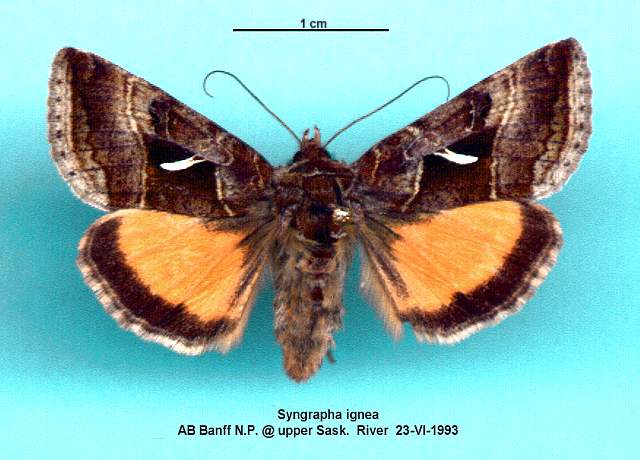Species Details
Syngrapha ignea
University of Alberta E.H. Strickland Entomological Museum Read more about this collection »
Common NameMountain Beauty
SeasonalityAdults have been collected in Alberta from late June through early August.
IdentificationA medium-size moth (2.9-3.2 cm wingspan) with reddish-brown forewings and bright yellow-orange hindwings. The forewings are brown with the lower two-thirds of the area between the antemedian and postmedian lines darker, almost black. Stigma is a silver dash and narrowly forked at the upper end. Hindwings are bright yellow-orange, with a black terminal band. Very similar to S. alticola, which has darker, blackish-brown forewings, a shorter stigma and a more zigzag terminal line. Other Syngrapha species with yellow hindwings (borea, orophila, microgamma) have mainly grey forewings and different stigmas. Autographa sansoni is larger and has pale yellow hindwings. There are also genitalic differences (see References). The antennae are simple and the sexes are similar. Older literature refers to ignea as S. hochenwarthi, a closely related Palearctcic species.
Scientific Name
Syngrapha ignea
Common Name
Mountain Beauty
Habitat
Subalpine and lower elevation meadows, roadsides, clearings, edges and other non-wooded habitats.
Seasonality
Adults have been collected in Alberta from late June through early August.
Identification
A medium-size moth (2.9-3.2 cm wingspan) with reddish-brown forewings and bright yellow-orange hindwings. The forewings are brown with the lower two-thirds of the area between the antemedian and postmedian lines…
A medium-size moth (2.9-3.2 cm wingspan) with reddish-brown forewings and bright yellow-orange hindwings. The forewings are brown with the lower two-thirds of the area between the antemedian and postmedian lines darker, almost black. Stigma is a silver dash and narrowly forked at the upper end. Hindwings are bright yellow-orange, with a black terminal band. Very similar to S. alticola, which has darker, blackish-brown forewings, a shorter stigma and a more zigzag terminal line. Other Syngrapha species with yellow hindwings (borea, orophila, microgamma) have mainly grey forewings and different stigmas. Autographa sansoni is larger and has pale yellow hindwings. There are also genitalic differences (see References). The antennae are simple and the sexes are similar. Older literature refers to ignea as S. hochenwarthi, a closely related Palearctcic species.
Life History
Adults of the Mountain Beauty are active both during the day and at night, and are attracted to lights. There is a single brood each season.
Conservation
A common widespread species; no concerns.
Diet Info
No Alberta data. The only available host plant information is from lab rearing at the CNC. Larvae in the lab were reared on blueberry (Vaccinium) but switched to willow (Salix) in the late instars.
Range
Primarily a western mountain species (northern Alaska south to southern California and New Mexico, with an apparently disjunct population in Labrador), but also found sparingly across the boreal forest and the…
Primarily a western mountain species (northern Alaska south to southern California and New Mexico, with an apparently disjunct population in Labrador), but also found sparingly across the boreal forest and the subarctic. In Alberta, it has been collected throughout the mountains and foothills, east to the Calgary and Lethbridge (?) areas. It should be watched for in the Alberta Cypress Hills and in the Boreal Forest region.
References
Author
Lafontaine, J. Donald and Robert W. Poole
Title
Noctuoidea : Noctuidae (part) : Plusiinae
Publication Date
1995
Pages
182
Author
Eichlin, Thomas D. and Hugh B. Cunningham
Title
The Plusiinae (Lepidoptera: Noctuidae) of America north of Mexico, emphasizing genitalic and larval morphology.
Publication Date
1978
Pages
122
Specimen Information
There are 94 specimens of this Species.
UASM163995 - Syngrapha ignea
University of Alberta E.H. Strickland Entomological Museum
Place CollectedCanada: Alberta, Bragg Creek
Collected BySperling, F.
Date Collected2001-07-09
UASM163996 - Syngrapha ignea
University of Alberta E.H. Strickland Entomological Museum
Place CollectedCanada: Alberta, Caribou Mountains Wildland Park, Wentzel Lake
Collected ByMacaulay, D.; Dunne, S.
Date Collected2003-07-12
UASM163997 - Syngrapha ignea
University of Alberta E.H. Strickland Entomological Museum
Place CollectedCanada: Alberta, Caribou Mountains Wildland Park, Wentzel Lake
Collected ByMacaulay, D.; Dunne, S.
Date Collected2003-07-12
UASM163998 - Syngrapha ignea
University of Alberta E.H. Strickland Entomological Museum
Place CollectedCanada: Alberta, Caribou Mountains Wildland Park, Wentzel Lake
Collected ByMacaulay, D.; Dunne, S.
Date Collected2003-07-10
UASM163999 - Syngrapha ignea
University of Alberta E.H. Strickland Entomological Museum
Place CollectedCanada: Alberta, Caribou Mountains Wildland Park, Wentzel Lake
Collected ByMacaulay, D.; Dunne, S.
Date Collected2003-07-09
UASM164000 - Syngrapha ignea
University of Alberta E.H. Strickland Entomological Museum
Place CollectedCanada: Alberta, Waterton Lakes National Park, Bellevue Hill
Collected BySchmidt, B. C.
Date Collected2005-07-07
UASM170001 - Syngrapha ignea
University of Alberta E.H. Strickland Entomological Museum
Place CollectedCanada: Alberta, West Castle River Road
Collected ByLawrie, D.
Date Collected2000-07-13
UASM170002 - Syngrapha ignea
University of Alberta E.H. Strickland Entomological Museum
Place CollectedCanada: Alberta, Kananaskis Country, Plateau Mountain
Collected ByLawrie, D.
Date Collected1990-07-23
UASM170003 - Syngrapha ignea
University of Alberta E.H. Strickland Entomological Museum
Place CollectedCanada: British Columbia, Pink Mountain
Collected BySperling, F.
Date Collected1998-07-04
UASM170004 - Syngrapha ignea
University of Alberta E.H. Strickland Entomological Museum
Place CollectedCanada: Alberta, Cardinal Divide
Collected ByDombroskie, J. J. et al
Date Collected2006-07-19
